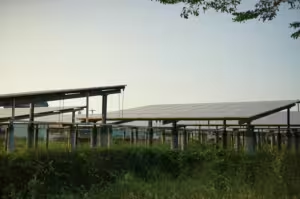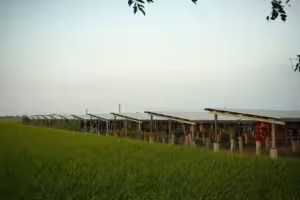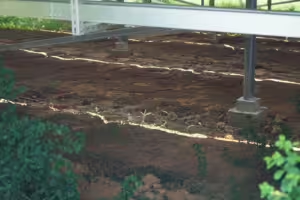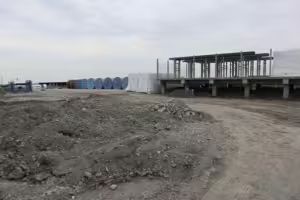Reporters/Kao Shih-Han,Shih Ruei-Han

Walking through the lush green fields of Tainan, vibrant shades of green stretch out as far as the eye can see. Among the verdant expanse, boards stand as silent markers, adding a technological air to the serene landscape.
Those are solar photovoltaic panels, gleaming under the sun, reflecting the nation’s commitment to net-zero emissions by 2050, partly through agrivoltaics, which refers to the combination of agriculture and photovoltaic solar energy production on the same land.
This dual-purpose approach has sparked diverse reactions among farmers: while some express concerns about potential disruptions to traditional agricultural practices, others see it as an opportunity to generate income by utilizing idle land.
Toward a net-zero Taiwan
“Solar photovoltaics give farmers a choice,” said Syu Ren-Bao, the mayor of Dacheng Township, where the population is aging and, though the specific number cannot be accessed, there is a large amount of abandoned land where weeds have started to prevail.
Now that the land can be used to “cultivate” both crops and electricity, if farming is too labor-intensive, “it would be far more profitable to use the land for the use of solar panels rather than let weeds take over,” he said.

In the background of Syu’s remark was a series of Taiwan government policies that intend to drive the country toward a net-zero island by 2050.
According to the Ministry of Economic Affairs’ goal, domestic renewable energy generation should account for 15.5 percent of the country’s total electricity generation by 2025, with solar power reaching 20 gigawatts.
As of September 2023, solar photovoltaic power had already reached 53.9 percent of the total, data compiled by the Renewable Energy Information Network indicated.
The Bureau of Energy explains that without affecting agricultural development, ground-mounted solar power can prioritize the installation of compound photovoltaic systems, such as aquaculture photovoltaics in areas unsuitable for agriculture or marginal agricultural land.
Unclear regulations
Despite the various potential benefits, B&B owner Wang Jia-Man and some environmental groups have pointed out that unclear land use regulations have caused a series of problems.
In 2016, for example, local media News & Market disclosed that many companies used land only for photovoltaic purposes while planting no crops as they were supposed to do according to the Agricultural Development Act, leaving solar panels. This led to many solar panels being decommissioned and subsequently abandoned.
Wang, a homestay operator in Tainan, pointed out that many local land use zoning areas were not approved by the government, and many abandoned solar panels still remain in place, with no companies removing them.
“If Taiwan is fully committed to green energy, it risks losing a significant amount of land,” Wang said.

Agrivoltaics are mainly installed on unfavorable agricultural land. Yet, recently many cultivated agricultural lands have been set up with solar panels.
“Some photovoltaic companies release incentives, making residents voluntarily rent their lands out to install solar panels,” said Wang.
Eco-friendly, really?
However, even amended rules and regulations do not necessarily dispel people’s doubts about the measure’s potential impact on the land.
Executive Director of Changhua Environmental Protection Union Shih Yue-Ying pointed out that soil salinization might happen if the solar panels touch the water. The columns may also release heavy metals at the same time.
Wang said Taiwan lacks long-term assessment and monitoring for ecological impacts caused by photovoltaics. Large-scale solar panels change landforms, potentially impacting biodiversity and ecological environments.
The Energy Bureau also planned a solar panel recycling mechanism with the Ministry of Environment. Random discarding is not allowed, and recycling fees will be collected by law, with strict implementation of recycling.
According to the Energy Bureau, operators are required to strictly implement recycling, for which the government will charge recycling fees.
The Energy Bureau stated that its future goal is to achieve mutual prosperity and coexistence of green energy and the ecological environment.
Demonstration zone in stalemate
The public’s doubt over the propriety of colocating agriculture and solar panels is epitomized by the Energy Bureau’s plan for a photovoltaic demonstration zone in Dacheng Township.
According to the initiative drafted in 2019, the demonstration zone is set to involve a field of around 339 hectares within Dacheng Township, where the bureau plans to install approximately 150,000 solar panels and generate an estimated amount of solar energy each year.
Currently, the land involved in the project is classified as low-yield and used primarily for sweet potatoes without fallow periods, said Shih.

However, this initiative has reached an impasse because no consensus has been reached.
Wang opposes methods like tree cutting and reservoir filling, which would be inevitable in the land reclamation process, calling for the public’s attention to their impact on the environment.
Meanwhile, Tsai Jia-Jin, chairman of the Taiwan Photovoltaic Industry Association, backs the project and said he believes the issues can be solved through effective management.
Syu Ren-Bao hopes that government promotion will boost public acceptance. Wang also emphasizes the interconnectedness of government efforts, stating that resolving the symbiosis controversy requires collaboration among stakeholders.
Shih said the government should disclose land change information, emphasizing the lack of public access to such information and the importance for people to know whether nearby photovoltaic fields will affect them.


